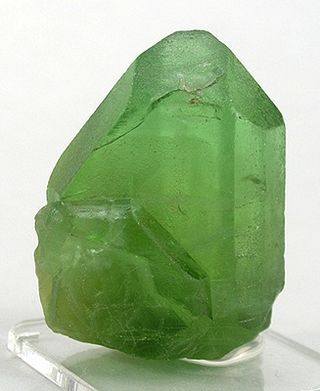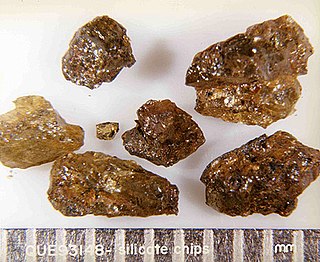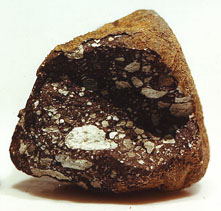
The mineral olivine is a magnesium iron silicate with the chemical formula (Mg,Fe)2SiO4. It is a type of nesosilicate or orthosilicate. The primary component of the Earth's upper mantle, it is a common mineral in Earth's subsurface, but weathers quickly on the surface. For this reason, olivine has been proposed as a good candidate for accelerated weathering to sequester carbon dioxide from the Earth's oceans and atmosphere, as part of climate change mitigation. Olivine also has many other historical uses, such as the gemstone peridot, as well as industrial applications like metalworking processes.

Peridot, sometimes called chrysolite, is a deep yellowish-green transparent variety of olivine. Peridot is one of the few gemstones that occurs in only one color.

Orgueil is a scientifically important carbonaceous chondrite meteorite that fell in southwestern France in 1864.

The pallasites are a class of stony–iron meteorite.

Iron meteorites, also known as siderites, or ferrous meteorites, are a type of meteorite that consist overwhelmingly of an iron–nickel alloy known as meteoric iron that usually consists of two mineral phases: kamacite and taenite. Most iron meteorites originate from cores of planetesimals, with the exception of the IIE iron meteorite group

The Fukang meteorite is a meteorite that was found in the mountains near Fukang, China in 2000. It is a pallasite—a type of stony–iron meteorite with olivine crystals. It is estimated to be 4.5 billion years old.

Pallasovka is a town and the administrative center of Pallasovsky District in Volgograd Oblast, Russia, located on the Torgun River, 301 kilometers (187 mi) northeast of Volgograd, the administrative center of the oblast. Population: 16,081 (2010 Census); 17,163 (2002 Census); 17,712 (1989 Census).

Brahin is a meteorite pallasite found in 1810. This is the second meteorite ever found in Russia. Sometimes it is also called Bragin or Bragim. It is quite common among collectors due to the affordable price of small partial slices.

Esquel is a meteorite found near Esquel, a Patagonian town in the northwest part of the province of Chubut in Argentina. It is a pallasite, a type of stony–iron meteorite that when cut and polished shows yellowish olivine (peridot) crystals.

Brenham is a pallasite meteorite found near Haviland, a small town in Kiowa County, Kansas, United States. Pallasites are a type of stony–iron meteorite that when cut and polished show yellowish olivine (peridot) crystals.

Krasnojarsk was the first pallasite meteorite ever found.

Huckitta is a pallasite meteorite recovered in 1937 from Huckitta Cattle Station in the Northern Territory of Australia.

Seymchan is a pallasite meteorite found in the dry bed of the river Hekandue, a left tributary of river Yasachnaya in the Magadan district, Russia, near the settlement of Seymchan, in June 1967.

Maricite or marićite is a sodium iron phosphate mineral (NaFe2+PO4), that has two metal cations connected to a phosphate tetrahedron. It is structurally similar to the much more common mineral olivine. Maricite is brittle, usually colorless to gray, and has been found in nodules within shale beds often containing other minerals.

Lodranites are a small group of primitive achondrite meteorites that consists of meteoric iron and silicate minerals. Olivine and pyroxene make up most of the silicate minerals. Like all primitive achondrites lodranites share similarities with chondrites and achondrites.

The Eagle Station group is a set of pallasite meteorite specimen that don't fit into any of the other defined pallasite groups. In meteorite classification five meteorites have to be found, so they can be defined as their own group. Currently only five Eagle Station type meteorites have been found, which is just enough for a separate group.
The Vermillion meteorite is a pallasite (stony-iron) meteorite and one of two members of the pyroxene pallasite grouplet.
This is a glossary of terms used in meteoritics, the science of meteorites.

The Chelyabinsk meteorite is the fragmented remains of the large Chelyabinsk meteor of 15 February 2013 which reached the ground after the meteor's passage through the atmosphere. The descent of the meteor, visible as a brilliant superbolide in the morning sky, caused a series of shock waves that shattered windows, damaged approximately 7,200 buildings and left 1,491 people injured. The resulting fragments were scattered over a wide area.

Allan Hills A81005 or ALH A81005 was the first lunar meteorite found on Earth. It was found in 1982 in the Allan Hills at the end of the Transantarctic Mountains, during a meteorite gathering expedition (ANSMET).

















